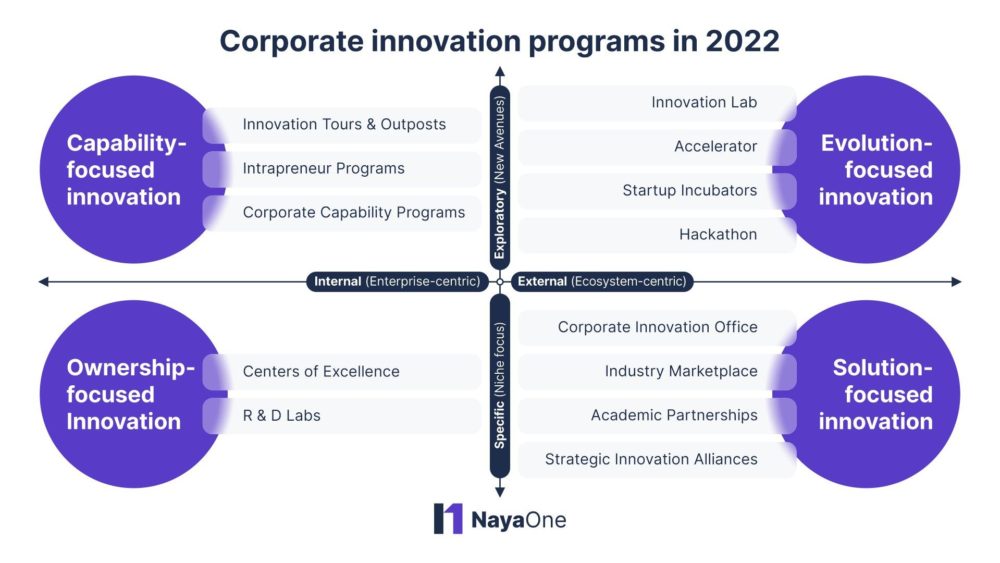
Ambar Vitelli-Khosla
Strategic Partnerships
The financial services industry is at an inflection point, undergoing radical changes driven by Covid-induced digital adoptions among consumers and enterprises, new competition from FinTechs and non-banks, regulatory initiatives reducing entry barriers, and the emergence of disruptive business models powered by modern technologies.
In a bid to increase competition and lower barriers to entry, regulators are enabling inclusive policies for participation from non-banking players that include digital banking licenses, open banking, and the launch of regulatory sandboxes. FinTech startups are no-more nibbling at the edges but are turning into financial superstores by re-bundling financial and even non-financial products to become a one-stop shop for customers’ needs.
Corporate Innovation Moves to the Top-shelf
These industry dynamics present new innovation imperatives for financial institutions to evolve their business models across the dimensions of digitalization and platformification. Digital-first business models are unlocking super-efficient and hyper-personalised ways to acquire and engage with specific customer cohorts. Platform-first business models have the potential to amplify monetization strategies through radical collaboration with fintechs and orchestrate a thriving ecosystem.
We are already witnessing megabanks such as Citi, Goldman Sachs, JPMorgan Chase, Barclays, Lloyds, Sberbank, DBS, ING, etc. that have started to respond with significant investments in various forms of innovation and innovation enablers, most notably in digital technologies, cloud infrastructure, agile ways of working and launching new ecosystem strategies in collaboration with fintechs.
The Future of Innovation: Open, Collaborative, and Pluralistic
Historically, corporate innovation in the financial sector has predominantly been an in-house activity with internal R&D teams working as independent centres of excellence to bring new product innovation to market. The time horizon for innovation used to be longer and the entire value chain from ideation to commercialization was managed with internal resources or in partnership with long-term strategic partners. The radical shifts that the industry has been going through have demanded financial institutions re-evaluate their approach towards innovation.
Looking at the gamut of innovation projects that have become prevalent in the financial services industry in recent years, we envisage a new innovation paradigm for financial institutions to launch and maintain their innovation portfolios.
The chart above articulates this new innovation paradigm. Let’s take a look at the dimensions of innovation approaches:
- On the vertical axis, firms need to evaluate the objectives of the innovation i.e. whether it is intended to solve a specific, well-defined problem that customers or employees are facing currently, or it is intended towards exploring new products, services, processes, and business models.
- On the horizontal axis, firms need to evaluate the mechanism through which they want to execute the innovation projects either through internal resources or in active collaboration with external partners.
These two dimensions give financial institutions four different mechanisms to initiate and operationalize their innovation projects.
- Ownership-focused innovation involves the traditional innovation approach that gives complete control over the innovation process and allows firms to own the business outcomes and intellectual property that comes from the innovation projects.
- Capability-focused innovation involves up-skilling and cross-skilling the personnel by exposing them to cross-functional or cross-organizational team set-ups and also inculcating entrepreneurial spirit among the employees.
- Solution-focused innovation involves engaging with industry innovators, academic researchers, and third-party marketplaces to explore solutions to specific problems around improving current products, services, or processes.
- Evolution-focused innovation involves unleashing a slew of collaborative mechanisms with fintechs, developers, enterprises to explore modern technology capabilities to launch new products, services, or business models.
NayaOne Powers a Spectrum of Innovation Approaches
Amidst the current dynamics of the industry, financial institutions would be well-positioned to leverage multiple innovation approaches simultaneously in order to deliver upon the short-term and long-term objectives of the organisation.
NayaOne, with its innovation enabling offerings, allows financial institutions to run different innovation projects either internally or in partnership with outside innovators.
For internal innovation projects, it provides tools for cross-functional data sharing, innovation dashboards for status tracking, and simulation tools to accelerate collaboration across business units, IT, and compliance teams.
For ecosystem-based innovation initiatives, it streamlines the entire process of identification, experimentation, and evaluation of startups and individuals who can offer innovative solutions to banks.
NayaOne enables a smooth transition from the proof of concept (PoC) or pilot stage to the production environment, so that the time-to-market from ideation to commercialization can be optimised, and the benefits of innovation can reach users quickly.






